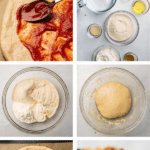Description
This easy whole wheat pizza dough is perfect for pizza night!
Ingredients
- 9 grams active dry yeast (2 ¼ teaspoons, or 1 packet)
- 12 grams honey (1 Tablespoon)
- 240 grams warm water (about 1 cup)
- 180 grams whole wheat flour (about 1 ½ cups)
- 180 grams all purpose flour (about 1 ½ cups)
- 7 grams kosher salt
- 20 grams olive oil, plus extra for drizzling
Instructions
Proof the yeast (10 minutes)
- Mix yeast, honey, and warm water in a large mixing bowl. Let sit for 5-10 minutes, until yeast is foamy.
Mix the dough & first rise (30 minutes)
- Add whole wheat flour, all purpose flour, kosher salt, and olive oil to the yeast mixture. Use a wooden spoon or sturdy spatula to stir everything together until no dry bits of flour remain. If it gets tough to stir the dough with a spoon, use clean hands to knead the dough together until it’s well mixed.
Note: You can continue to knead this dough by hand (5-10 minutes) or with the dough hook on a stand mixer (3-5 minutes) until it’s smooth and elastic if you like; this will develop more gluten for a smoother dough and a bit more chew. If you’re short on time or just don’t feel like putting in that much elbow grease, just mix the dough until no dry bits of flour remain (it’s ok if it’s still a little shaggy and sticky!) We have tested this recipe with and without additional kneading and it’s good either way, so feel free to adjust based on your personal preference! In the photos above, we mixed the dough until it was just combined (with no additional kneading).
- Once the dough is thoroughly mixed, cover with a clean tea towel and let rise at room temperature for 30 minutes.
Fold dough & second rise (30 minutes)
- Run your hands under a bit of cold water (this helps prevent the dough from sticking). Gently slide your hands under the pizza dough and fold each edge in towards the center, almost like you’re folding an envelope. You’re not really kneading the dough here, per se - you’re more just folding it into a neater little dough ball. The dough may feel pretty sticky here - that’s ok! Just run your hands under a little more cold water if it’s sticking too much. You’ll feel the dough begin to tighten up as you fold it.
- Drizzle the dough ball with a bit of olive oil, then give it a turn until it’s evenly coated. Re-cover with the tea towel and let rise another 30 minutes, until you’re ready to shape and bake your pizza.
Shape & Bake
- Line a large cutting board with a piece of parchment paper, then gently stretch or roll the dough into shape on the parchment (we like using a piece of parchment paper here to make it easy to slide our dough in and out of the oven).
- Top with your favorite sauce, cheese, and toppings and bake with your favorite method. We like to bake pizza on a hot baking steel at 450-500°F for 10-20 minutes until the cheese is bubbly and the crust is golden brown.
Notes
How much dough does this recipe make? This recipe makes enough for one large (~14") pizza, two medium (~8-10") pizzas, or 4-6 individual pizzas (depending on how thin you stretch your dough!) One batch of dough is usually enough for 2-3 large portions (with no side dishes) or 4 smaller portions (perfect for serving with a quick salad).
How warm should my “warm water” be? A good rule of thumb is “warm to the touch.” Too-hot water (130° F and above) will kill your yeast, but use too-cold water and your yeast will take too long to activate. We usually shoot for a water temperature between 95° and 110° Fahrenheit. You should be able to comfortably hold your hand under water running at about 100 degrees – it should feel quite warm, but not hot. Use a kitchen thermometer for a precise measurement if you like!
Substitutions. Use bread flour in place of all purpose flour. Add dried or fresh herbs, roasted garlic, or grated parmesan cheese when you mix the dough for extra flavor. Use sugar or maple syrup instead of honey.
Please use a kitchen scale if you can! Measuring by weight with a kitchen scale is much more accurate than measuring by volume (with cups). Because each person measures a cup of flour a little bit differently, it's easy to end up using way too much flour in a recipe - which results in dry, dense crust! When you measure your flour in grams with a kitchen scale, you can measure flour perfectly every time.
Mix this dough by hand OR with a stand mixer - it works well either way! If you use a stand mixer, fit it with the dough hook and add the flour a little bit at a time to ensure the mixer incorporates everything evenly. Let the mixer run an additional 3-5 minutes once all the flour is incorporated to develop the gluten in the dough more fully for a stronger, smoother dough.
Adjusting the rise time. If your kitchen is especially chilly, you may need to let the dough sit another 15-30 minutes during the first rise.
For more ideas and instructions about flour types, dough shapes, and other substitutions and techniques, be sure to enroll in our Everyday Artisan Bread course.


